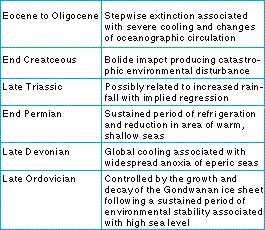Mass extinction

In the history of life there have been mass extinctions in which extraorinarily high numbers of species have gone extinct in a short period of time. For example at the end of the Permian it has been estimated that as many as 96% of marine species went extinct.
The most thoroughly studied of these extinctions is the Cretaceous-Tertiary mass extinction in which the dinosaurs and many other vertebrae were wiped out.
It has been controversially suggested that large extinctions occur cyclically, with a wavelength of roughly 26 million years. The problem is that it is hard to distinguish between real and pseudo extinctions in the fossil record: for this reason, among others, the 26 million year cycle is not widely accepted.
Despite the disagreements over what constitutes an extinction, the five largest extinctions have been identified, as the figure shows.
Figure: mass extinctions and their possible causes, suggested by various authorities. Simplified from Donovan (1989).
| Next |



